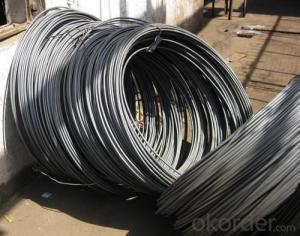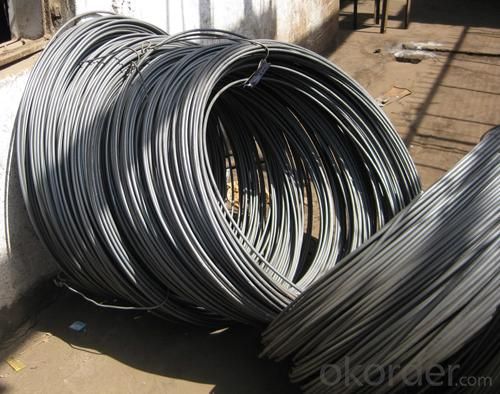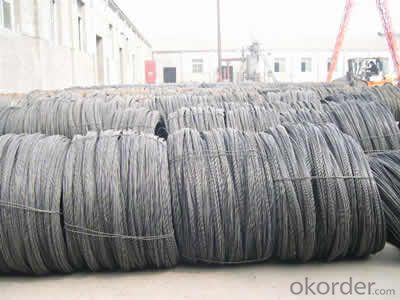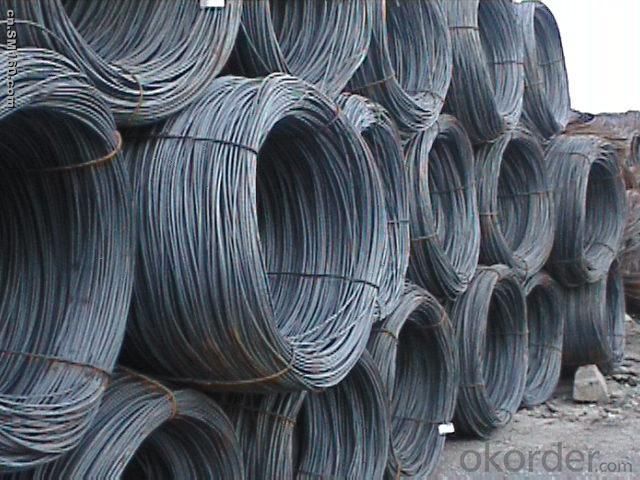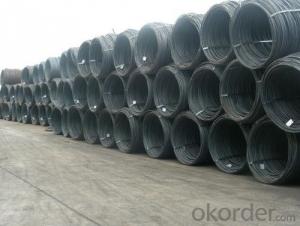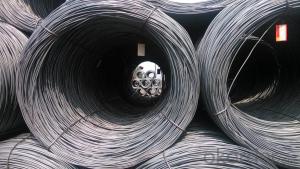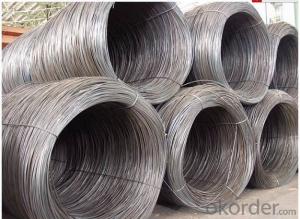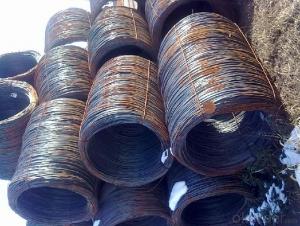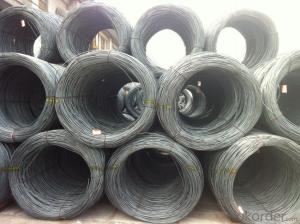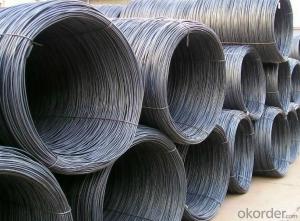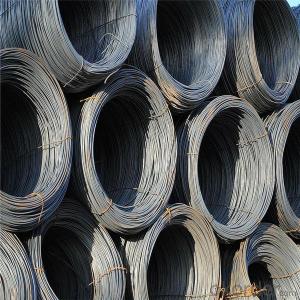Hot Rolled Carbon Steel Wire Rod 12mm with High Quality
- Loading Port:
- China Main Port
- Payment Terms:
- TT or LC
- Min Order Qty:
- 25 m.t.
- Supply Capability:
- 20000 m.t./month
OKorder Service Pledge
OKorder Financial Service
You Might Also Like
Product Description:
OKorder is offering Hot Rolled Carbon Steel Wire Rod 12mm with High Quality at great prices with worldwide shipping. Our supplier is a world-class manufacturer of steel, with our products utilized the world over. OKorder annually supplies products to European, North American and Asian markets. We provide quotations within 24 hours of receiving an inquiry and guarantee competitive prices.
Product Applications:
Hot Rolled Carbon Steel Wire Rod 12mm with High Quality is widely used in construction and manufacturing. Carbon steel wire rod is mainly used for reinforcement of reinforced concrete and welded structure or reprocessed (roberts , nail, etc.) materials, especially used to produce wire drawing, welding electrode, nails, spring, electronic, precise machinery parts and so on.
Product Advantages:
OKorder's Hot Rolled Carbon Steel Wire Rod 12mm with High Quality are durable, strong.
Main Product Features:
· Premium quality
· Prompt delivery & seaworthy packing (30 days after receiving deposit)
· Can be recycled and reused
· Mill test certification
· Professional Service
· Competitive pricing
Product Specifications:
Manufacture: Hot rolled
Grade: SAE1006 SAE1008 SAE1010 SAE1012 SAE1016 SAE1018
Certificates: ISO, SGS, BV, CIQ
Weight per Coil:2-2.05tons
Packaging: Export packing, packed by coil
FAQ:
Q1: Why buy Materials & Equipment from OKorder.com?
A1: All products offered byOKorder.com are carefully selected from China's most reliable manufacturing enterprises. Through its ISO certifications, OKorder.com adheres to the highest standards and a commitment to supply chain safety and customer satisfaction.
Q2: How do we guarantee the quality of our products?
A2: We have established an advanced quality management system which conducts strict quality tests at every step, from raw materials to the final product. At the same time, we provide extensive follow-up service assurances as required.
Q3: How soon can we receive the product after purchase?
A3: Within three days of placing an order, we will begin production. The specific shipping date is dependent upon international and government factors, but is typically 7 to 10 workdays.
Q4: What is the diameter tolerance?
A4: Around +/-0.03mm
Images:
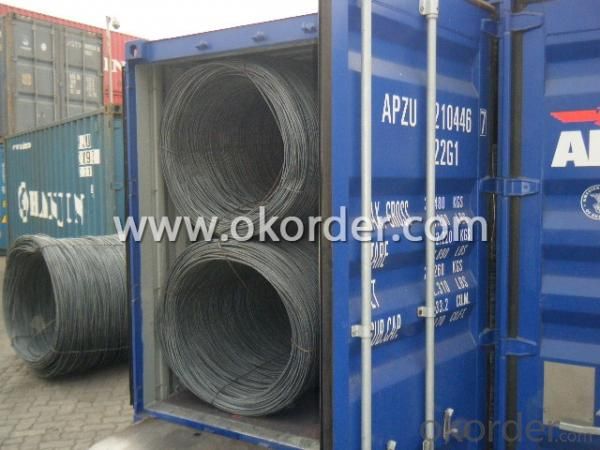
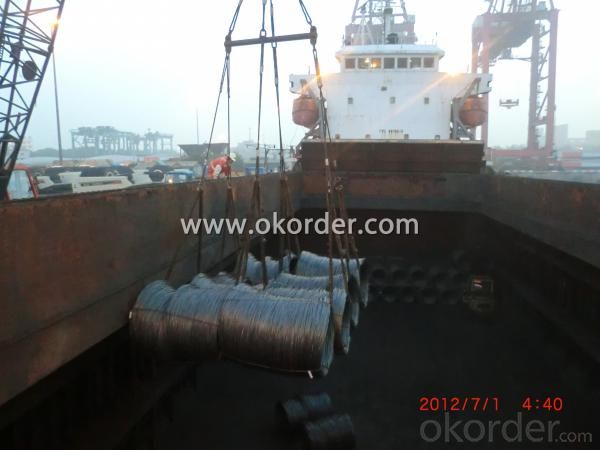
- Q: How is steel wire rod used in the manufacturing of wire forms for signage?
- Wire forms for signage rely heavily on steel wire rod as a crucial element in their manufacturing process. The wire rod serves as the primary material for shaping and designing wire forms. To begin with, careful selection of the steel wire rod is based on its specific mechanical and chemical properties, such as tensile strength and resistance to corrosion. These properties guarantee the durability and ability of the wire forms made from the rod to withstand diverse weather conditions. Following the selection, the steel wire rod undergoes a series of manufacturing steps. Typically, the rod is drawn through a sequence of dies to reduce its diameter and increase its length. This wire drawing process enables the production of wires with precise dimensions and smooth surfaces. After achieving the desired thickness, the wire is further processed to create the specific shapes and forms required for signage. This may involve bending, coiling, or welding the wire into various configurations, depending on the design specifications. Once the wire forms are shaped using the steel wire rod, they are utilized in the manufacturing of signage. These wire forms often function as structural frameworks or supports for different types of signage, such as letters, logos, or decorative elements. They provide the necessary stability and rigidity to hold the signage in place, ensuring its integrity and visibility. Furthermore, the versatility of steel wire rod allows for the creation of intricate and complex wire forms that can be customized to meet specific design requirements. This design flexibility enables the production of visually captivating and distinctive signage, enhancing its aesthetic appeal and brand recognition. In conclusion, steel wire rod plays a vital role in the manufacturing of wire forms for signage. It serves as the raw material from which wire forms are shaped, providing the necessary strength and durability required for signage applications. The ability to customize wire forms allows for the creation of visually appealing and distinctive signage, making steel wire rod an indispensable component in the signage industry.
- Q: What are the factors that affect the mechanical properties of steel wire rod?
- The mechanical properties of steel wire rods are influenced by several factors. 1. Composition: The chemical composition of steel, including the presence of alloying elements such as carbon, manganese, silicon, and others, determines its mechanical properties. Different compositions result in varying levels of strength, toughness, and ductility. 2. Microstructure: The microstructure of steel, including grain size and distribution, also affects its mechanical properties. Fine-grained steels generally exhibit higher strength and improved toughness compared to coarser-grained ones. Heat treatment processes can be used to control the microstructure and enhance desired properties. 3. Heat treatment: Various heat treatment processes, such as annealing, quenching, and tempering, can significantly alter the mechanical properties of steel wire rods. These processes modify the structure and hardness of the material, providing desired levels of strength, hardness, and ductility. 4. Processing conditions: The mechanical properties of steel wire rods can also be influenced by the processing conditions during manufacturing. Factors such as the temperature, rate of cooling, and deformation applied during rolling, drawing, or extrusion processes can affect the final properties. Proper control of these parameters is crucial to achieving the desired mechanical properties. 5. Surface finish: The surface condition of steel wire rods can impact their mechanical properties. A smooth and clean surface is generally preferred as it reduces the likelihood of cracks, improves fatigue resistance, and enhances overall performance. 6. Impurities and defects: The presence of impurities, such as sulfur, phosphorus, and non-metallic inclusions, can negatively impact the mechanical properties of steel wire rods. Similarly, manufacturing defects like cracks, voids, and inhomogeneities can weaken the material and reduce its strength. 7. Environmental factors: The environment in which steel wire rods are used can affect their mechanical properties. Variables such as temperature, humidity, exposure to corrosive substances, and mechanical loading conditions can all influence the material's behavior, including its strength, ductility, and corrosion resistance. In conclusion, the mechanical properties of steel wire rods are influenced by factors such as composition, microstructure, heat treatment, processing conditions, surface finish, impurities, defects, and environmental factors. Understanding and controlling these factors are crucial in producing steel wire rods with desired mechanical properties for various applications.
- Q: How is steel wire rod packaged for transportation and storage?
- Steel wire rod is typically packaged for transportation and storage in a way that ensures its protection and ease of handling. The packaging process involves several steps to ensure the safety and integrity of the product. Firstly, steel wire rod is usually bundled together using steel straps or wires. These bundles are tightly secured to prevent any movement or damage during transportation. The size and weight of the bundles may vary depending on the specific requirements and dimensions of the wire rods. To further protect the wire rod from external factors such as moisture, dust, and corrosion, it is often coated with a layer of oil or other rust-resistant material. This coating helps to maintain the quality and durability of the wire rod during storage and transportation. The bundles of steel wire rod are then stacked and stored in a warehouse or on a pallet for easy handling and efficient use of space. The pallets are usually made of wood, plastic, or metal and are designed to withstand the weight and pressure of the wire rod bundles. The pallets also facilitate the use of forklifts or other lifting equipment for loading and unloading purposes. In terms of transportation, steel wire rod is typically loaded onto trucks, trains, or ships for long-distance transportation. During loading and unloading, proper lifting equipment is used to ensure the safety and integrity of the bundles. The wire rod bundles are secured and fastened to prevent any movement that could potentially cause damage. Overall, the packaging for transportation and storage of steel wire rod involves securely bundling the wire rod, applying a protective coating, stacking and storing on pallets, and using appropriate lifting equipment for transportation. These measures are essential to ensure the safety, quality, and integrity of the wire rod during its journey from the manufacturing facility to the end destination.
- Q: How is steel wire rod used in the production of tire reinforcement materials for heavy-duty vehicles?
- Steel wire rod is used in the production of tire reinforcement materials for heavy-duty vehicles as it provides strength and durability. The wire rod is typically formed into cords or strands and then embedded within the rubber compound of the tire. This reinforcement helps to enhance the tire's structural integrity, improve its load-carrying capacity, and increase its resistance to wear and tear. Overall, steel wire rod plays a vital role in ensuring the performance and longevity of tires used in heavy-duty vehicles.
- Q: How is steel wire rod made?
- Steel wire rod is made through a process called hot rolling, where steel billets are heated and passed through a series of rolling mills to reduce their diameter and increase their length. This continuous process enhances the mechanical properties of the steel, ensuring it meets the desired strength and flexibility requirements. The resulting wire rod is then coiled and cooled before being further processed into various applications such as nails, fences, or construction materials.
- Q: How are surface defects in steel wire rod repaired or rectified?
- Surface defects in steel wire rods can be repaired or rectified through various methods. One common approach is to remove the defects by grinding or polishing the affected area to remove any surface imperfections. Alternatively, the defective portion can be cut off entirely, resulting in a shorter rod. In more severe cases, heat treatment techniques might be employed to improve the overall quality of the wire rod. Ultimately, the specific repair method will depend on the nature and extent of the surface defect.
- Q: How is the ductility of steel wire rod determined?
- The ductility of steel wire rod is determined through various mechanical tests and measurements. One of the commonly used methods to evaluate ductility is the tensile test. In this test, a sample of the steel wire rod is pulled until it breaks, and the amount of deformation it undergoes before fracture is measured. During the tensile test, the steel wire rod is subjected to an increasing load or force, while its elongation or deformation is continuously measured. The force required to stretch the wire to a specific length is recorded, and the resulting stress-strain curve is plotted. The ductility of the steel wire rod can be determined from this stress-strain curve. The elongation or deformation at the point of fracture is an important parameter in assessing its ductility. Higher elongation indicates greater ductility, as it implies that the material can undergo more deformation before breaking. Apart from the tensile test, other tests such as the bend test and impact test can also be used to evaluate the ductility of steel wire rod. In the bend test, the wire is bent to a specific angle without fracturing. The ability to bend without breaking indicates good ductility. Similarly, the impact test measures the energy absorbed by the wire when it is subjected to a sudden impact. A higher energy absorption indicates better ductility, as it implies that the material can absorb and distribute the impact forces without fracturing. In conclusion, the ductility of steel wire rod is determined through mechanical tests such as the tensile test, bend test, and impact test. These tests measure the amount of deformation the wire can undergo before breaking, the ability to bend without fracturing, and the energy absorption during impact, respectively.
- Q: How is steel wire rod used in the production of suspension springs for railway vehicles?
- Steel wire rod is used in the production of suspension springs for railway vehicles as it provides the necessary strength and durability required to withstand the heavy loads and constant vibrations experienced in rail operations. The steel wire rod is first shaped and coiled into the desired spring design, ensuring proper tension and flexibility. These suspension springs are then integrated into the suspension system of railway vehicles, helping to absorb shocks, maintain stability, and provide a smooth and comfortable ride for passengers and cargo.
- Q: What is the yield strength of steel wire rod?
- The yield strength of steel wire rod can vary depending on the specific grade and composition of the steel. However, on average, the yield strength of steel wire rod ranges from 300 to 500 megapascals (MPa).
- Q: How are steel wire rods used in the production of brush wires?
- Brush wires are created using steel wire rods, which act as the main raw material for high-quality brush bristles. These wire rods, typically made from carbon steel, offer the strength and durability needed for brush wires. To begin the production process, the wire rods are fed into a wire drawing machine where they are pulled through dies to decrease their diameter. This step is repeated until the desired thickness is achieved. The wire is then cut into specific lengths for use as brush bristles. The mechanical properties of steel wire rods make them the preferred choice for brush wires. The carbon steel used in these rods has high tensile strength, enabling the brush bristles to withstand regular use without breaking or bending easily. Moreover, the steel wire rods provide flexibility, which is vital for creating brush bristles that can effectively clean hard-to-reach areas. After the wire drawing process, the brush wires can undergo additional treatments to enhance their performance. This may involve heat treatment to improve hardness and springiness or coating the wires with materials like nylon or brass to add functionality and durability. Once the brush wires are prepared, they can be incorporated into various types of brushes, including toothbrushes, industrial brushes, and paintbrushes. The use of steel wire rods in their production ensures that the resulting brush wires are strong, resilient, and capable of effectively performing their cleaning or scrubbing functions. In conclusion, steel wire rods play a vital role in brush wire production as they offer the necessary strength, durability, and flexibility required for brush bristles. Through a wire drawing process, these wire rods are transformed into brush bristles of the desired thickness. The use of steel wire rods ensures that the final brush wires can endure regular use and effectively clean different surfaces.
Send your message to us
Hot Rolled Carbon Steel Wire Rod 12mm with High Quality
- Loading Port:
- China Main Port
- Payment Terms:
- TT or LC
- Min Order Qty:
- 25 m.t.
- Supply Capability:
- 20000 m.t./month
OKorder Service Pledge
OKorder Financial Service
Similar products
Hot products
Hot Searches
Related keywords
